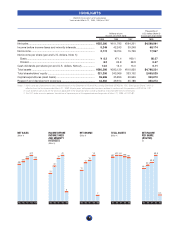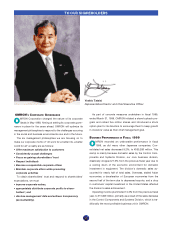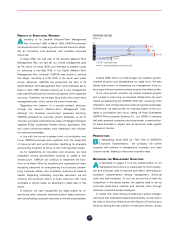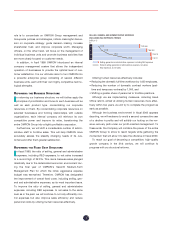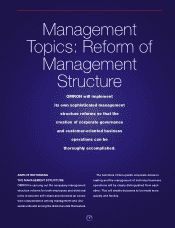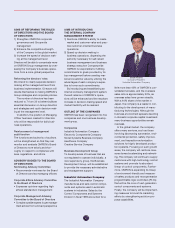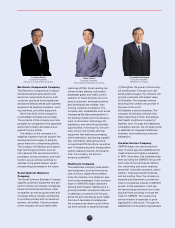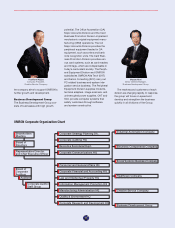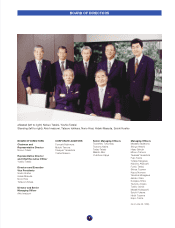Omron 1999 Annual Report Download - page 6
Download and view the complete annual report
Please find page 6 of the 1999 Omron annual report below. You can navigate through the pages in the report by either clicking on the pages listed below, or by using the keyword search tool below to find specific information within the annual report.
role is to concentrate on OMRON Group management and
Groupwide policies and strategies, initiate meaningful discus-
sion on corporate strategy, guide decision making, increase
shareholder trust, and improve corporate worth. Managing
officers, on the other hand, will focus on the management of
individual business units and promote business activities that
are more clearly focused on customer needs.
In addition, in April 1999 OMRON introduced an internal
company management system that allows the independent
operation of businesses to provide the optimal level of cus-
tomer satisfaction. It is our ultimate vision to turn OMRON into
a powerful enterprise group consisting of several different
business units, each with their own highly competitive techno-
logical strengths.
REFORMING THE BUSINESS STRUCTURE
In reforming our business structure, we will further apply the
principles of prioritization and focus to each business unit as
well as each product type, concentrating our corporate
resources on them. By concentrating corporate resources on
selected businesses and forming relationships with outside
organizations, each internal company will reinforce its own
competitive power and improve its value, transforming the
entire OMRON Group into a highly profitable corporation.
Furthermore, we will shift a considerable number of admin-
istrative staff to frontline sales. This will help OMRON more
accurately assess the steadily changing needs of its cus-
tomers and offer them greater satisfaction.
REFORMING THE FIXED COST STRUCTURE
In fiscal 1999, the ratio of selling, general and administrative
expenses, including R&D expenses, to net sales increased
to a record high of 32.3%. This rise is because sales plunged
drastically due to the deteriorated economic environment dur-
ing the final year of OMRON’s Seventh Medium-Term
Management Plan for which the initial, aggressive expense
budget was earmarked. Therefore, OMRON has designated
the improvement of overall fixed costs, including selling, gen-
eral and administrative expenses, as its most important issue.
To improve the ratio of selling, general and administrative
expenses, including R&D expenses, to net sales to the same
level as in the past, we will continue to not only efficiently con-
trol expenses but also improve sales efficiency and reduce
personnel costs by utilizing human resources effectively.
Utilizing human resources effectively includes:
• Reducing the domestic full-time workforce by 1,000 employees,
• Reducing the number of domestic contract workers (part-
time and temporary workers) by 1,000, and
• Shifting a greater share of personnel to frontline positions.
Although we are implementing measures, including Head
Office reform, aimed at utilizing human resources more effec-
tively within two years, we will try to complete the program as
early as possible.
Although the business environment in fiscal 2000 appears
daunting, we will endeavor to avoid a second consecutive year
of a decline in profits and will solidify our footing on the rev-
enue recovery path under our profit-oriented management. To
these ends, the Company will combine the power of the entire
OMRON Group to strive to reach targets while gathering the
momentum that will allow it to take the offensive in fiscal 2000.
To reach our goal of becoming a competitive, high-quality
growth company in the 21st century, we will continue to
progress with our structural reforms.
4
143,550
165,351
178,318
179,117
SELLING, GENERAL AND ADMINISTRATIVE EXPENSES
(INCLUDING R&D EXPENSES) TRENDS
(Million ¥)
’96
’97
’98
’99
FY
Selling, general and administrative expenses, including R&D expenses
Ratio of selling, general and adminstrative expenses, including
R&D expenses, to net sales
27.3
27.8
29.1
32.3



